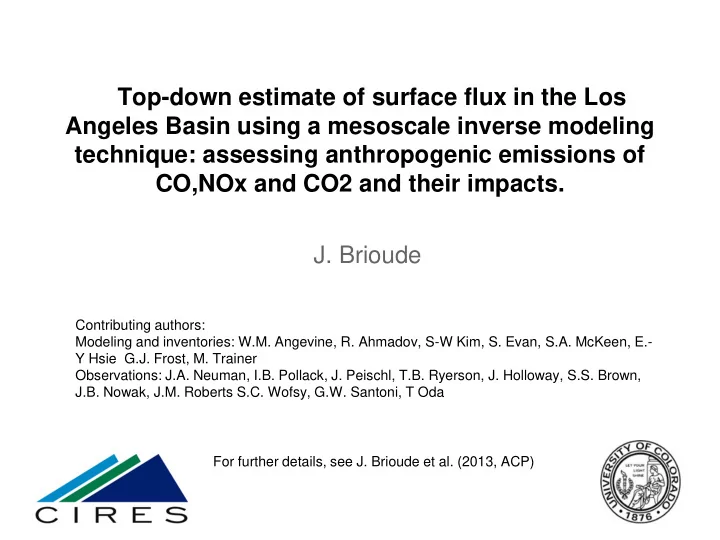

Top-down estimate of surface flux in the Los Angeles Basin using a mesoscale inverse modeling technique: assessing anthropogenic emissions of CO,NOx and CO2 and their impacts. J. Brioude Contributing authors: Modeling and inventories: W.M. Angevine, R. Ahmadov, S-W Kim, S. Evan, S.A. McKeen, E.- Y Hsie G.J. Frost, M. Trainer Observations: J.A. Neuman, I.B. Pollack, J. Peischl, T.B. Ryerson, J. Holloway, S.S. Brown, J.B. Nowak, J.M. Roberts S.C. Wofsy, G.W. Santoni, T Oda For further details, see J. Brioude et al. (2013, ACP)
Outline 1. Observations and inversion method 2. Differences in CO,NOy and CO2 between the posterior and existing inventories (NEI, CARB) 3. Trend between 2002 and 2010 4. Application: Ozone Chemistry in the LA basin with WRF-Chem
CALNEX 2010 and ITCT 2002 CO flux in NEI 2005 SoCAB - 6 flights (3 weekday flights in blue, 3 weekday flights in green) during CALNEX 2010 are used to evaluate LA basin anthropogenic emissions - 1 flight during ITCT 2002 is used to evaluate the emissions in 2002 - CO,NOy and CO2 tracers in FLEXPART are assumed passive. => Variability of single-flight-based inversion is about 10 to 15%, depending on the chemical species used
Weekday/weekend effects (at least in the US) • Large reductions in NOx emissions on weekends relative to weekdays result in higher weekend ozone production e ffi ciencies (Pollack et al., 2012). Due to differences in truck traffic. Red=weekday, Blue=weekend 4
Lagrangian inversion method -WRF
Log normal distribution assumed for CO and NOx observations and parameters background Gaussian distribution Lognormal distribution Gaussian distributions let observations be negative below background. Lognormal distributions are closer to reality
No bias found in the meteorology Observed CO Simulated CO by FLEXPART From Angevine et al., (2012)
Optimization of CO surface fluxes at mesoscale - NEI 2005 used as a prior for weekday and weekend flights CO flux in Posterior, weekday CO flux in Posterior, weekend CO flux in NEI 2005 Differences(%) Posterior-NEI reduction of ~40% in LA county.
Simulated vs Observed CO above background - Using NEI - Using Posterior
CO flux estimates - Posterior close to CARB 2008, but lower by 37% compared to NEI 2005 - Weekend effect of -15% in the posterior, consistent with Pollack et al (2012) and NEI(-19%). Opposite sign in CARB.
Optimization of NOx surface fluxes at mesoscale - NEI 2005 used as a prior for weekday and weekend flights NOx flux in Posterior, weekday NOx flux in Posterior, weekend NOx flux in NEI 2005 Differences(%) Posterior-NEI reduction of ~30% in LA county. factor of 5 reduction the in the Port of LA
NOx flux estimates - Posterior close to CARB 2008. Lower by 27 to 40% compared to weekday NEI 2005. - Strong weekend effect of -40% in the posterior. In agreement with weekend effect in NEI (-29%) and CARB (35%). - Difference with CARB 2008 statistically insignificant
Optimization of anthropogenic CO2 fluxes at mesoscale - No prior estimates used. We used the flux ratio inversion method (Brioude et al., 2012, JGR) based on CO,NOx best estimates and linear correlations with CO2 CO2 flux in Posterior, weekday CO2 flux in Posterior, weekend
CO2 flux estimates 183±18 Tg/year of CO2 based on the posterior. Good agreement with CARB. Higher than Vulcan by 15 to 38%.
Strong reduction in NOx and VOC emission Bishop and Stedman, 2008; Dallman and Harley, 2010 for NOx (Courtesy Si-Wan Kim.) Warneke et al., 2012 JGR Reduction of 7.8% per year Reduction of 37% within the past 8 years (McDonald et al., 2012) 15
Los Angeles from 2002 to 2010 Reductions of 41% in CO emission and 37% in NOx emission found in the posterior between 2002 and 2010 No trend found in CO2 surface fluxes. Consistent with published studies. The CO2 trends (+10 %± 14 % in LA, -4 %± 10 % in SoCAB) are statistically insignificant.
Inventory evaluation in 4x4km WRF-Chem runs WRF-Chem model Domains D1: Western US (12x12km2 resolution) D2: California (4x4km2 resolution) Credit: Ravan Ahmadov, Stuart McKeen
Inventory evaluation in 4x4km WRF-Chem runs No Chem NEI CARB10 Posterior Posterior CARB10 2005 (2008) NEI VOC CARB VOC (2013) NO2 No bias level r=0.64 r=0.70 r=0.73 r=0.73 r=0.67 Compared to Brioude et al. (2013), photolysis rate of O 1 D has improved. NOy No Chem NEI CARB10 Posterior Posterior CARB10 2005 (2008) NEI VOC CARB VOC (2013) r=0.65 r=0.70 r=0.73 r=0.74 r=0.69
Inventory evaluation in 4x4km WRF-Chem runs No Chem NEI CARB10 Posterior Posterior CARB10 2005 (2008) NEI VOC CARB VOC (2013) CO r=0.54 r=0.60 r=0.60 r=0.60 r=0.61 CO discrepancy with NOAA P3 in-situ measurements are largely reduced using the CO posterior compared to NEI 2005. The best results are found using CARB 10 (version 2008 or 2013)
Inventory evaluation in 4x4km WRF-Chem runs Ozone CARB10 Posterior Posterior CARB10 Ozone chemistry was also evaluated NEI 2005 (2008) NEI VOC CARB VOC (2013) with the WRF-Chem simulations. The No Chem ozone error is -6ppb using NEI and - r=0.75 r=0.80 r=0.75 r=0.84 r=0.80 10 using CARB inventory. The ozone bias=-6 bias=-9.7 bias=+3.5 bias=-4 bias=-4.3 error ranges between -4 and +3.5ppb using the CO and NOy posteriors and NEI or CARB VOCs. - In WRF-Chem, biases reduced and correlations improved using CO and NOy posteriors
Conclusions • The inversion seems to do a decent job in estimating surface fluxes of CO, NOy and CO 2 at mesoscale • Trend in the posteriors between 2002 and 2010 matches the trends in the observations • NEI 2005 inventory agrees within 40% for CO and NOy posterior emissions in 2010 • Good Agreement with CARB 2008 and 2010 • Single-flight-based inversions have an uncertainty of ~15% and can be used to evaluate existing bottom-up inventories • For further information, see Brioude et al., 2013, ACP
Recommend
More recommend